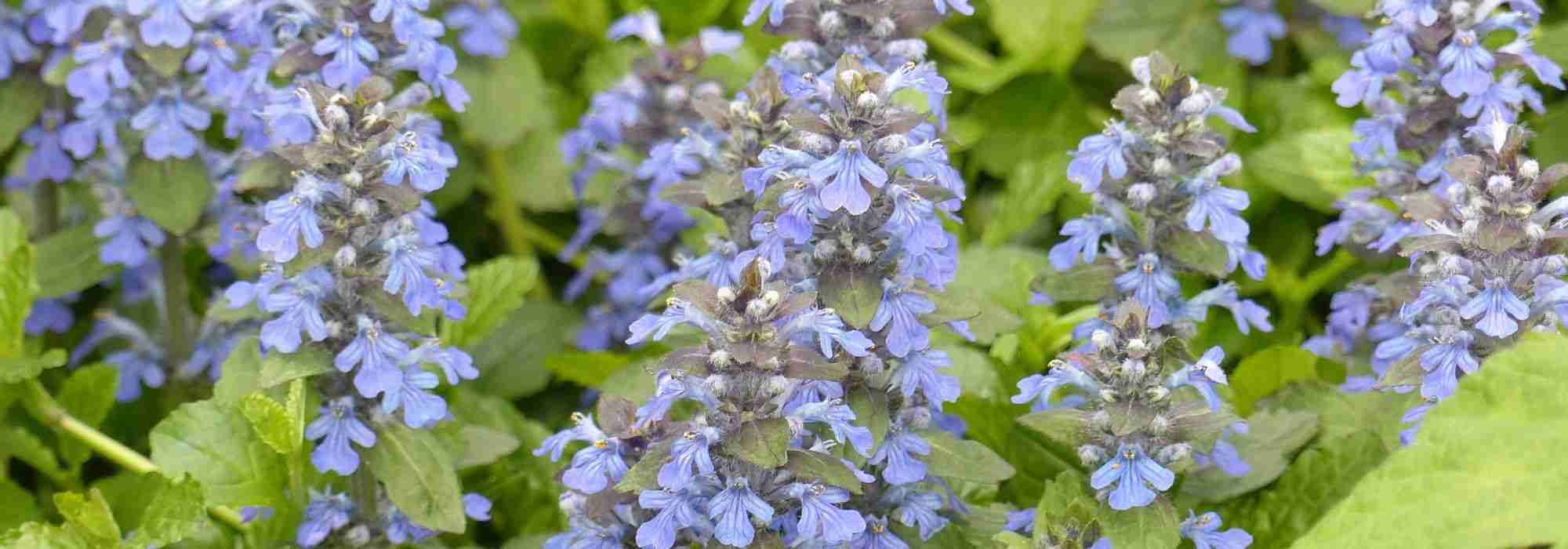
How to pair Ajuga?
Ideas and inspirations for pairing creeping bugle in the garden
Contents
The ajuga or creeping bugle is a small perennial that forms delightful little cushions of colour.
Easy to grow, it thrives in shaded or part-shaded areas, heavy and moist soils, but is also perfectly suited for flowering pots, from which it can cascade beautifully.
Its spring or summer flowering can be blue, pink, or white. Its evergreen and glossy foliage can be green, purple, or variegated.
In the garden, it can be paired with other plants to brighten up a shady corner, as well as in fresh rockeries, borders, or alongside spring bulbs. The ajuga can also create contrasting colourful scenes or, conversely, perfectly harmonious ones.
Here are our ideas for successful combinations!
In a shady yet bright garden
Ajuga thrives in partial shade or shade, heavy clay soils, and moist soils: areas that are often challenging to plant and brighten in the garden.
Whether in woodland or another shaded spot, our plant will naturally pair with other species that have these same specific needs. Together, they can even be suitable for cultivation around ponds or water features.
Dare to add colour by combining creeping bugle with astilbes with feathery flowers, which will bring height and lightness. Choose a lovely gradient or shades of pink, pairing the uncommon Ajuga reptans ‘Gold Chang’ or ‘Purple Torch’ with pink, purple, or mauve astilbes. Alternatively, opt for contrasts by growing blue and pink varieties side by side. For a softer touch, prefer the refined look of cultivars with white flowers.
The filipendulas or meadowsweet will also add a lot of lightness with their airy white, red, or pink blooms.
On the side of particularly decorative foliage, hostas will certainly be ideal candidates. Their large leaves in various colours will pair beautifully with the rounded and crinkled or incised leaves of ajuga. To bring more light, choose varieties with variegated or golden foliage.
To add a graphic and modern touch to the ensemble, grow Matteuccia, such as the German fern, with its beautiful feathery fronds.
To play even more with heights, look towards loosestrifes with beautiful bright pink spikes, or towards the lush ligularias with large yellow flower spikes. Measuring about 1 to 2 metres in height, they will complement the small creeping silhouette of ajugas very well.
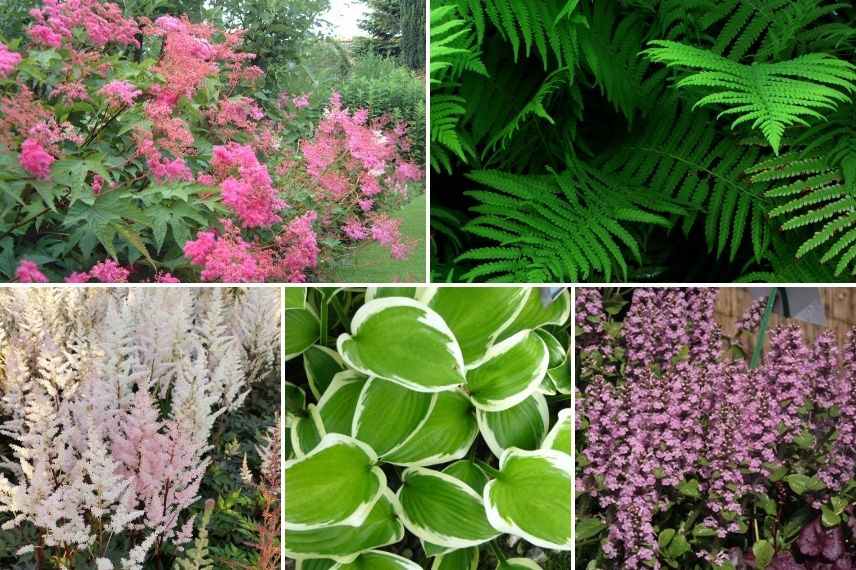
Filipendula purpurea, Matteuccia pensylvanica (photo katja schulz), Astilbe arendsii ‘Bumalda’, Hosta ‘Queen Josephine’, Ajuga reptans ‘Rosea Purple’
Read also
How to choose an ajuga?In a lovely, varied flower bed
Due to its small size, creeping bugle is ideal for the front of borders or as a groundcover. In a partially shaded and cool area, it will be accompanied by other perennial plants with a creeping habit and small stature.
Our ajuga will then be paired with lady’s mantle groundcovers, which will provide a beautiful synchronisation of flowering in spring and summer. The blue-flowering creeping bugles (‘Variegata’, ‘Catlin’s Giant’, ‘Princess Nadia‘…) will pair well with the yellow-flowering varieties of lady’s mantle for a complementary display (Alchemilla erythropoda or Alchemilla mollis ‘Thriller’).
Hostas, dead nettles, and heucheras will also make good companions, with beautiful decorative and colourful foliage.
The bugle will also pair very well with light grasses: Japanese grasses (Hakonechloa) will be perfect for a modern and graphic touch, with their arching leaves sometimes displaying vibrant colours. To add verticality and structure, also consider molinia or the very tolerant miscanthus (1 to 3 metres tall).
Veronicastrums will also provide height in the background with their slender spikes of colourful flowers, rising in summer like candelabras.
In terms of colours, the creeping bugles with cream and green variegated foliage (‘Variegata’ or Ajuga incisa ‘Frosted Jade’) will highlight vibrant pink flowers, such as those of Bleeding Heart (Dicentra formosa ‘Luxuriant’ or Dicentra eximia ‘Stuart Boothman’) or primroses (Primula japonica and ‘Millers Crimson’).
The creeping bugles with dark foliage like the beautiful ‘Black Scallop’ with its almost black chocolate bronze foliage, or ‘Atropurpurea’ with its purple highlights will be used to enhance light-coloured flowers. For example, consider pairing them with comfreys with white flowers (Symphytum ‘Hidcote Blue’, Symphytum grandiflorum).
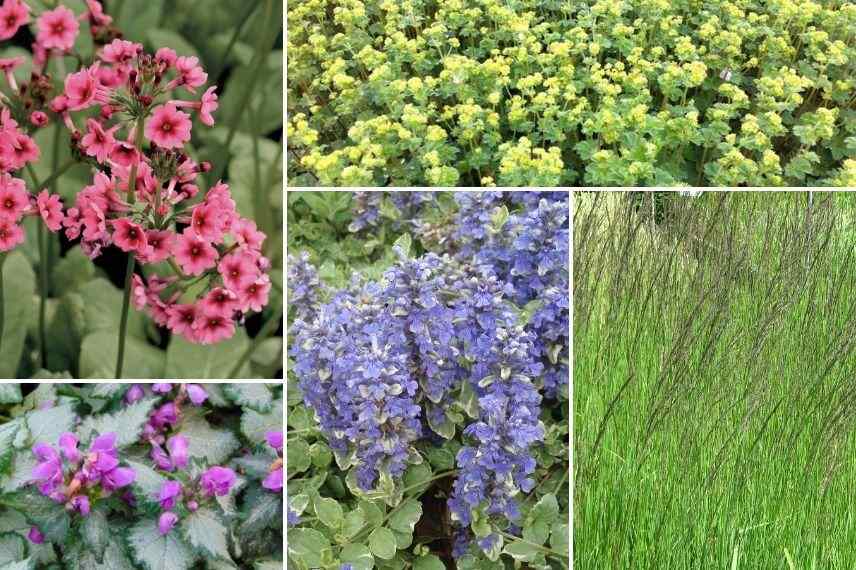
Primula japonica ‘Miller’s Crimson’, Alchemilla erythropoda, Lamium maculatum ‘Beacon Silver’, Ajuga reptans ‘Variegata’, Molinia caerulea arundinacea ‘Fontäne’
Discover other Ajuga
View all →Available in 2 sizes
Available in 2 sizes
Available in 2 sizes
Available in 1 sizes
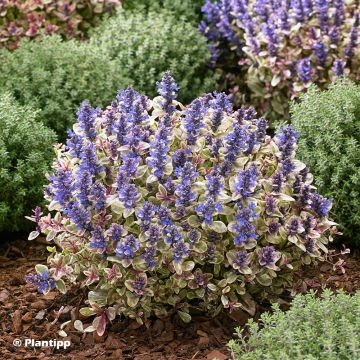
Available in 2 sizes
Available in 1 sizes
Available in 3 sizes
Available in 2 sizes
Available in 1 sizes
Available in 2 sizes
Pairing Ajuga in Pots
The small silhouette of ajuga is ideal for creating beautiful flowering pots. It is easy to grow in pots, bowls, or window boxes, from which it will gracefully spill over in a mini cascading effect.
Pair it with the lovely bell-shaped flowers of campanulas. You can choose to create a monochrome scene in shades of blue or pink, establish a romantic atmosphere by combining white varieties, or dare to mix colours for a wilder look.
The small, shaded flowers of forget-me-nots will also complement our ajuga. They will add a delicate touch of romance to the pot.
Hardy geraniums that enjoy cool, even moist, soils will also be good companions: the gentle Geranium maculatum ‘Espresso’ and ‘Vickie Lynn’, the delicate ‘Album’, the striking Geranium palustre, or the splendid Geranium versicolor.
For a natural touch and a very fresh style, opt for primroses in a variety of colours. There is something for everyone.
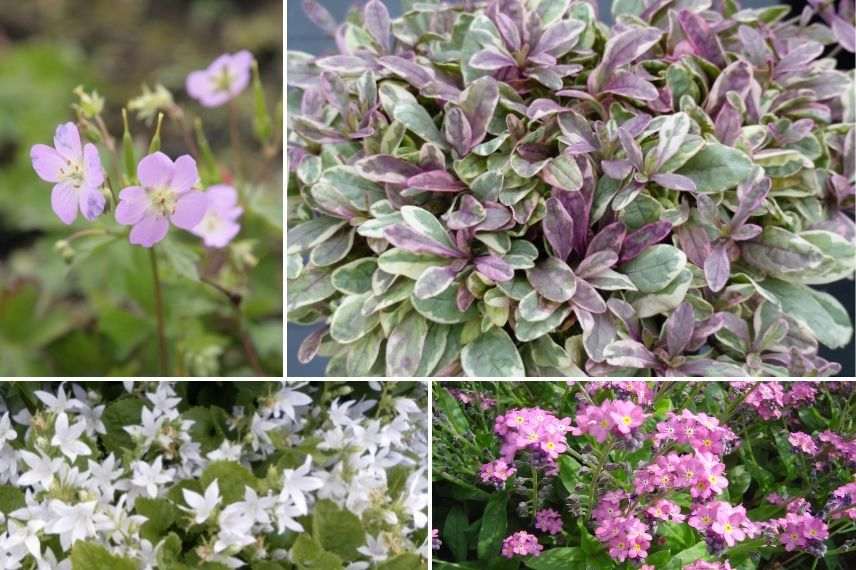
Geranium maculatum ‘Vickie Lynn’, Bugle-Ajuga tenorii Princess Nadia, Campanula poscharskyana ‘EH Frost’, Myosotis sylvatica ‘Rosylva’ (photo David Monniaux)
Read also
10 plants to create a shady rockeryIn a colourful fresh rockery
The creeping bugle can be cultivated in rockeries, in a partially sunny area, as long as the soil remains sufficiently moist, especially during the summer months.
Alongside it, the rosettes of evergreen leaves from saxifrages will also form small, colourful flowering cushions. Choose white or pink varieties for a lovely harmony of shades with the creeping bugles. The subulate sagina will also find its place, with its moss-like texture and small white flowers appearing at the end of spring. Also consider the Solomon’s seal, which will precede their flowering with its small tubular flowers, or the pink primrose.
You can also turn to the Scheuchzer’s rampion (Phyteuma scheuchzeri), a cousin of campanulas native to the mountainous regions of Europe, featuring spherical inflorescences of intense blue. The corydalis, also a mountain perennial, will brighten the rockery with its tubular flowers, such as Corydalis lutea, which blooms from May to October.
The dwarf hostas will bring a lot of light with their foliage, especially if you choose variegated cultivars (Hosta ‘Color Festival’, ‘Lakeside Paisley Print’, ‘Pocketfull of Sunshine’ or the tiny ‘Mighty Mouse’).
To take over the flowering at the end of summer, consider the delicate cyclamens that bloom in summer and autumn, such as the white Naples cyclamen, which will be covered in white flowers from August to October, before revealing its evergreen foliage in winter.
On the side of grasses that will add volume to the overall effect, the highly diverse carex, or the woodland luzula with its light flowering will be perfect.
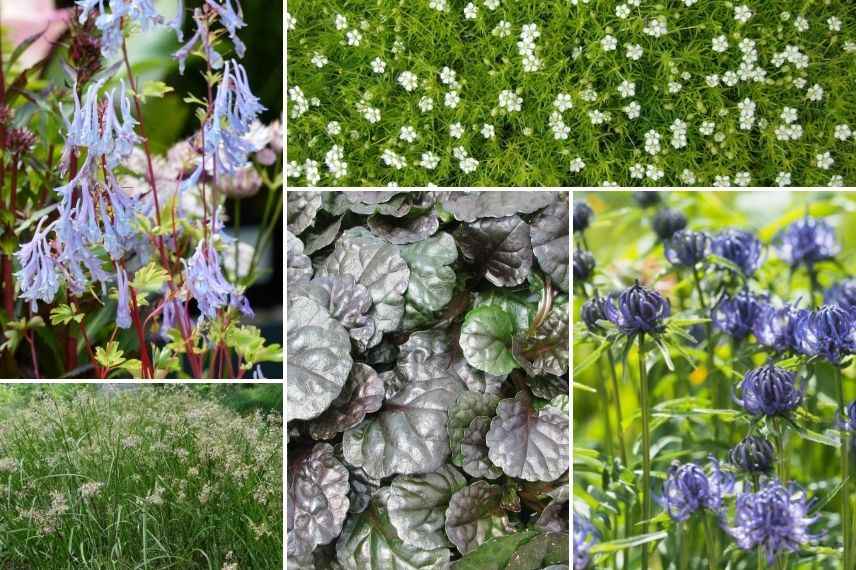
Corydalis ‘Blue Line’, Sagina subulata (photo Wikipedia), Luzula sylvatica (photo Wikipedia), Ajuga reptans ‘Black Scallop’ (photo Serres Fortier), Phyteuma
With spring bulbs
They gently and refreshingly announce the return of fine days: spring bulbs. They will be good companions for the evergreen foliage of our creeping bugle, which they will precede in flowering.
Generally, the snowdrops will show the tips of their petals first. In this combination, also consider hyacinths in pink, blue, or white.
The timeless spring crocuses, with varieties flowering in blue-purple-grey tones, will create a beautiful monochrome scene, alongside ajugas like ‘Braunherz’ or the Ajuga tenorii ‘Chocolate Chip (Valfredda)’ with its lovely chocolate foliage.
Also adopt cyclamens, with their pretty butterfly-wing flowers (Cyclamen coum ‘White’ or ‘Pink’), wood anemones with their charming full blooms, the must-have daffodils or botanical tulips, which will gently announce the end of spring.
Also consider the edible wild garlic, flowering in beautiful white umbels at the end of spring. Its bright green lanceolate foliage can be accompanied by certain varieties of variegated creeping bugle to bring plenty of light, such as Ajuga reptans ‘Multicolor’, ‘Golden Glow’ or Ajuga tenorii ‘Dixie Chip’.
And to take over, the colchicums will be ideal at the end of summer and will accompany the evergreen foliage of ajugas.
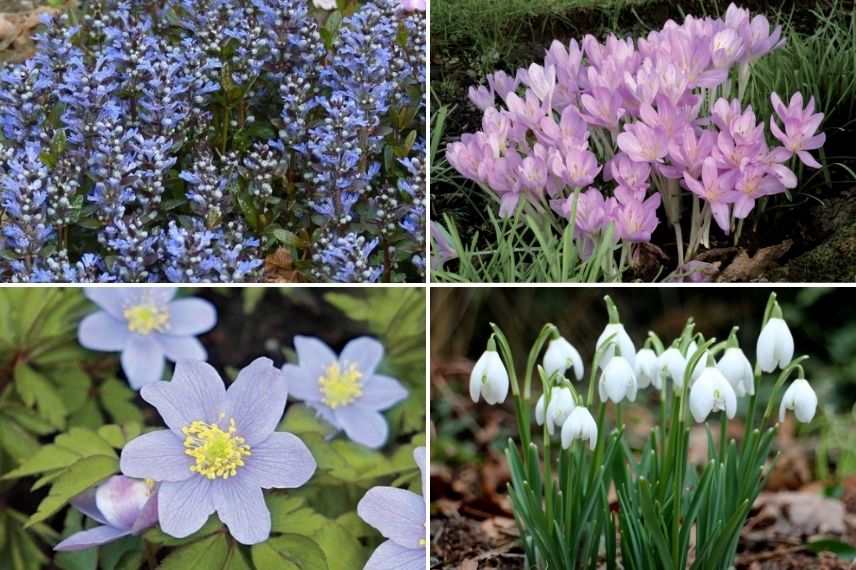
Ajuga tenorii ‘Chocolate Chip’, Colchicum ‘The Giant’, Anemone nemorosa ‘Robinsoniana’ and Galanthus nivalis (photo Wikipedia)
To dress the bases of trees and bushes
To green the bases of trees or bushes and create beautiful textured and colourful carpets, creeping bugles are unmatched. They will not fear root competition and will benefit from the natural shade provided by their large companions, who, in turn, will keep their bases nice and cool.
They will accompany, for example, fargesias (non-running bamboo), Virginia Magnolia, exotic marsh hibiscus (Hibiscus moscheutos), Virginia Itea, or even willows.
With these plants, cultivate other perennial groundcovers such as dwarf varieties of hostas, corydalis, or even tiarellas and heucherellas, like the bright ‘Honey Rose’ with its stunning bronze-purple foliage turning honey.
The brunneras and acaenas, plants with astonishing decorative fruits, as well as asarums with their heart-shaped foliage can perfectly complete the picture.
Also think about the pulmonarias, whose flower colours will pair very well with ajuga, or the beautiful hellebores that will dress the garden in winter or early spring.
Finally, for the originality of their flowers, elfin plants (Epimedium) will also create a lovely pairing with creeping bugle, particularly with the dark foliage of ‘Black Scallop’ or ‘Atropurpurea’ that will beautifully highlight the colour nuances.
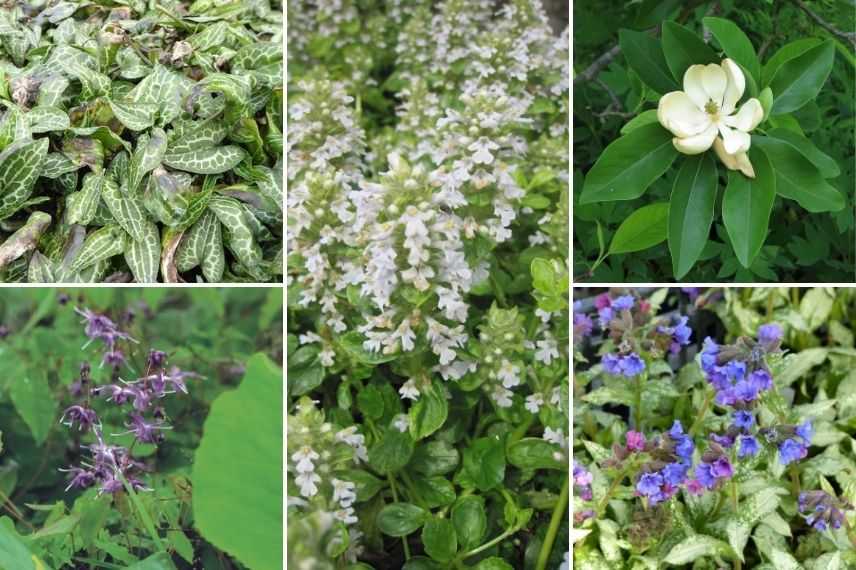
Asarum epigynum ‘Takasago Saishin’ (photo Guido), Ajuga reptans ‘Sanne’, Magnolia virginiana ‘Glauca’, 10-Epimedium grandiflorum ‘Lilafee’ (photo PBK), Pulmonaria ‘Diane Clare’
- Subscribe!
- Contents
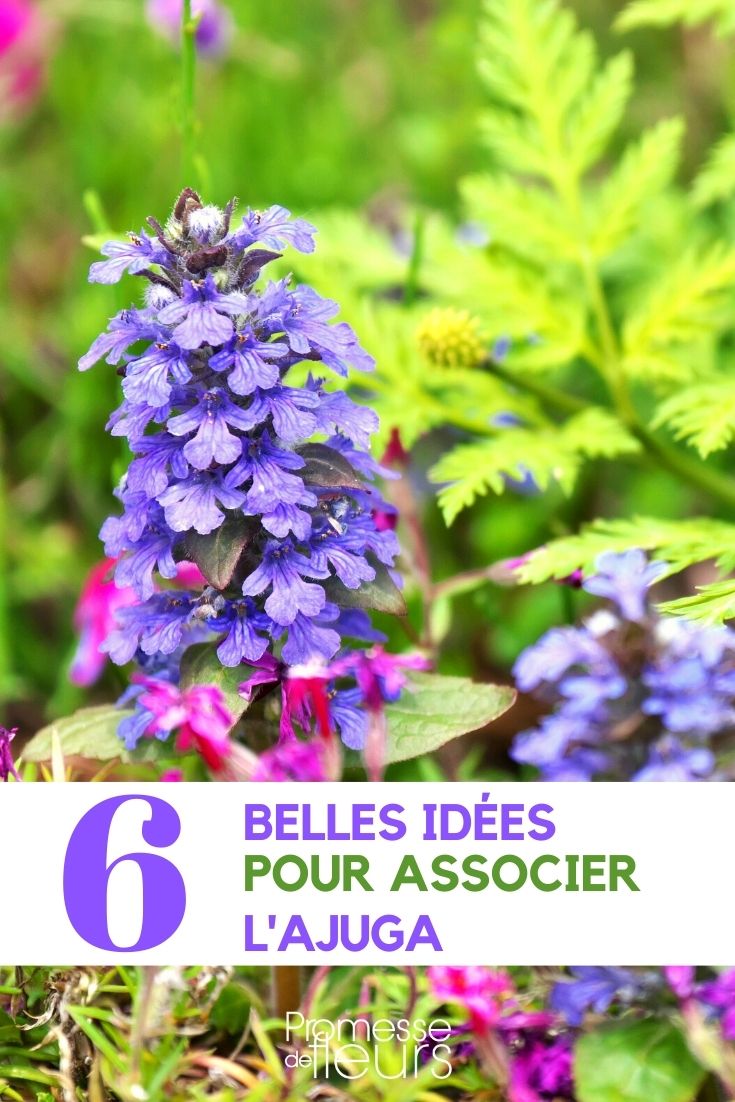































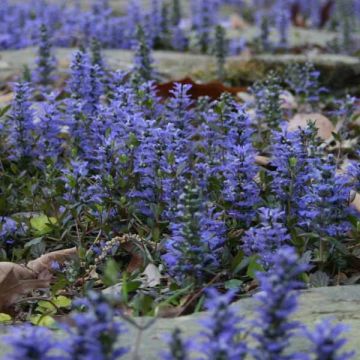
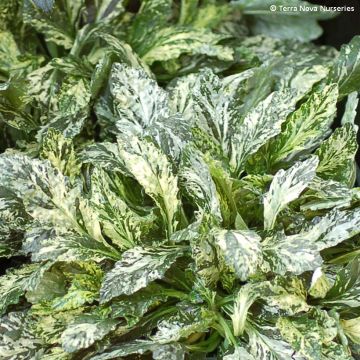
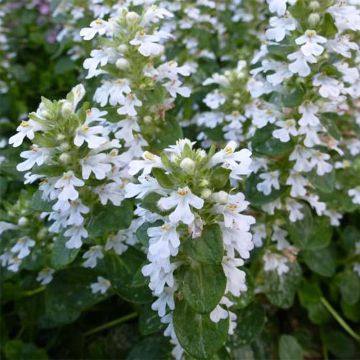
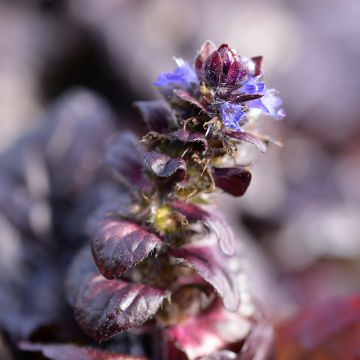
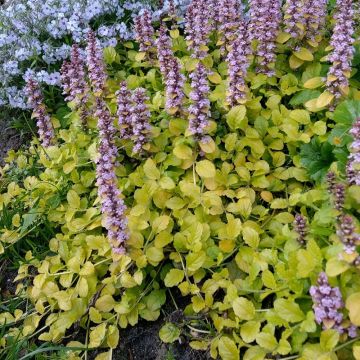
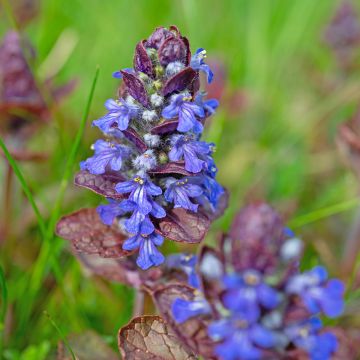
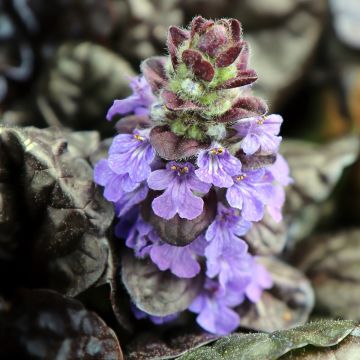
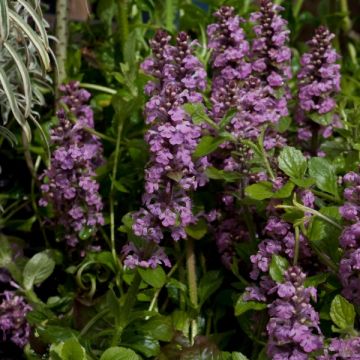
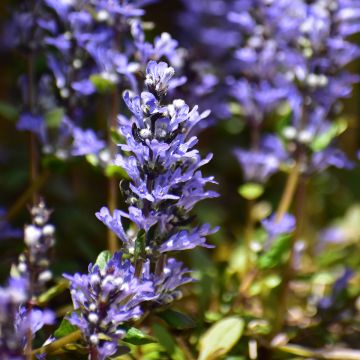
Comments